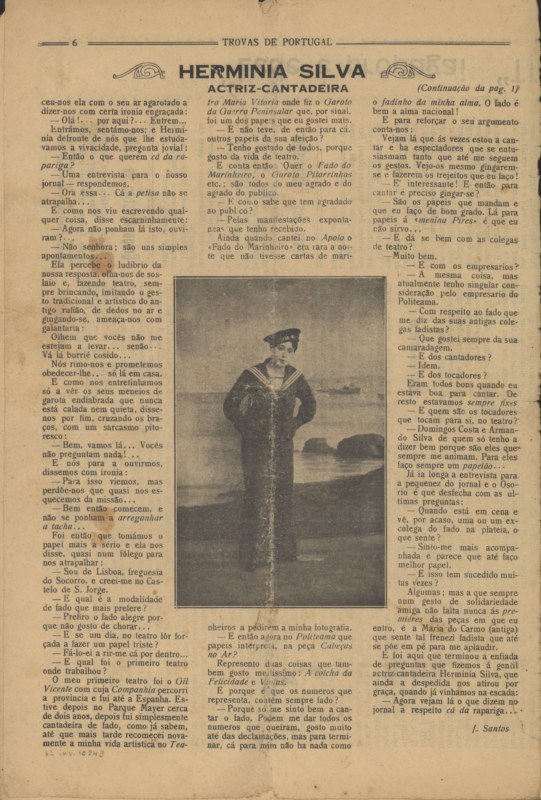Know more:
Hermínia Silva
(N. 23 October, 1907 - M. 13 June, 1993)Hermínia Silva, her full name being Hermínia Silva Leite Guerreiro, was born at Hospital de São José, in Lisbon, at the Socorro district, on the 23 October 1907. She had one older sister, Emília, and a younger brother, Artur. When she was eight months-old the family moved to the Castelo district.
She worked as a seamstress apprentice at a tailor in Rua dos Fanqueiros, in Lisbon, but soon became interested in having an artistic life. A frequent visitor of the Sociedade de Recreio Leais Amigos, she eventually registered as an amateur actress in 1925. She sang her first fados with piano accompaniment.
Hermínia Silva made her debut as an amateur at the Sociedade Recreativa Leais Amigos, in 1925. In 1926 she joined the Tournée Artística Gil Vicente and toured Portugal, acting on stages at Vila Franca, Alenquer, Grândola, Alcácer do Sal, Santiago do Cacém, Sines, Odemira, Albufeira, Silves, Fuzeta, Lagos, Tavira and Vila Real de Santo António. This tour also passed by Spain.
The fado singer always considered that she had begun her career in 1926, upon joining the "Tournée Artística Gil Vicente" organised by maestro A. Júlio Machado and his son Victor Machado (who later wrote the book "Ídolos do Fado"). This "Tournée Artística Gil Vicente" included, in addition to Hermínia Silva, actors Maria de Vasconcelos, Berta Moreira, Agripino de Oliveira, Artur Cunha, João Amaral, Pais Condessa and Raquel de Sousa (later on also a singer). Hermínia Silva achieved great success both as actress and singer.
On the 9 April 1927, Hermínia Silva was the mother of a boy who she named Mário Silva. She became an established fado singer, first at theatre Malacaio, where she sang at the end of the movie sessions, and later at Valente das Farturas in Parque Mayer.
Hermínia Silva also wanted to be theatre artist and performed fado songs in three plays, at the Esplanada Egípcia of Parque Mayer, in 1929: "Ouro Sobre Azul", "De Trás da Orelha" and "Off Side".
In the coming years she performed as a fado singer at the former Cervejaria Jansen, Salão Artístico de Fados, Solar da Alegria and Café Luso. Due to her traditional “castiça” voice, Hermínia Silva was invited to join the cast of operetta "Fonte Santa", in which she made her debut in this genre in 1932, singing a few fado songs.
She performed an acting role in her next play, 1933 vaudeville play "Feijão Frade", in which she ranked second in the cast, right after the famous actress Beatriz Costa.
Her theatre performances increased from this year onwards. In theatre Hermínia Silva showed her unmistakable talent of fado singer, together with a natural comedian gift. In such way that newspaper critics constantly remembered her creations: "We rejoice at seeing, both on stage and in other settings, this girlish fado star representing characters that are remarkable for their picturesque nature. Her «travestis», from the «faia de "Tendinha"» to the «provinciano reservista» have been worthy of the best praises from the most demanding critics." (Cf. "Guitarra de Portugal", 10 April 1939).
In the 1930’s and 1940’s Hermínia Silva was the most important fado singer in vaudeville theatre. Her major hits were sung at these theatres, namely "Velha Tendinha" (in the 1934 "Zé dos Pacatos" vaudeville play), "Rosa Enjeitada" (in the 1936 "Arre Burro!" play), and "Mãos Sujas" (in the 1937 "Chuva de Mulheres").
In her first cinema character, the fado singer represented the role of Maria da Luz, in the movie "A Aldeia da Roupa Branca" directed by Chianca de Garcia in 1938. Hermínia Silva co-starred with Beatriz Costa, Óscar de Lemos and José Amaro, singing "Fado da Fadista" and "Fado do retiro".
Five years later, in 1943, she performed a new cinema role in movie "O Costa do Castelo", directed by Artur Duarte. Her character, fado singer Rosa Maria, sang "Fado da Saudade" and "Fado Rosa Maria", co-starring with António Silva, Milú and Maria Matos.
Hermínia Silva also played roles in films "Um Homem do Ribatejo" (1946) and its 1949 sequel "Ribatejo", both directed by Henrique de Campos. In the first she sang "Fado da Sina" and in the second "Fado da Cigana".
The fado singer would appear on the cinema screen only once more, in 1969, in the film "O Diabo Era Outro", directed by Constantino Esteves. Featuring António Calvário in the main role, the movie included two scenes filmed at Solar da Hermínia.
Her participation in vaudeville plays (Teatro de Revista) would be quite constant, from 1932 to 1958, when she decided to open her own fado house. Among others, here as some vaudeville plays in which she performed:
"Sempre em Pé" (Teatro Variedades, 1938); "Iscas com Elas" (Teatro Apolo, 1938); "O Banzé" (Teatro Maria Vitória, 1939); "Bailarico" (Teatro Variedades, 1940); "Boa vai ela!" (Teatro Maria Vitória, 1941); "Boa Nova" (Teatro Variedades, 1942); "Toma Lá Dá Cá" (Teatro Maria Vitória, 1943); "Rosa Cantadeira" (Teatro Apolo, 1944); "O Tiroliro" (Teatro Avenida, 1946); "’Tá Bem ou não ‘tá?" (Teatro Avenida, 1947); "Ai, Bate Bate" (Teatro Variedades, 1948); "Ora Agora Viras Tu" (Teatro Variedades, 1949); "Fogo de Vistas" (Teatro Maria Vitória, 1950); "Lisboa Antiga" (Teatro Apolo, 1953); "De bota abaixo" (Teatro Apolo, 1955); "Daqui fala o Zé" (Teatro ABC, 1956); "A Casa da Sorte" (Teatro ABC, 1957).
In 1950 she also performed in two declaimed plays, "História de uma Fadista" and "Sempre em Festa".
In 1949 Hermínia Silva married Manuel Guerreiro. Her career however remained closely associated with theatre, performing in several plays on the stages of Teatro Maria Vitória, Variedades, Apolo, Politeama and Avenida. She was paid a tribute in the Teatro Avenida in December 1945.
On the 13 May 1958 she opened Solar da Hermínia with her husband. Shortly afterwards she opened Pôr-do-Sol in Benavente, a venue where she presented fado shows on Saturday nights and Sunday afternoons. From then on she performed essentially at her place in Largo Trindade Coelho, until it closed down on the 23 October 1982. At that time the fado singer ceded the place to poet José Luís Gordo.
For the delight of her fans she returned to vaudeville plays, but only sporadically, with "Ai Venham Vê-las" (1964), "Afinal como é?" (1975)and "Cada cor seu paladar" (1976), all on the stage of Teatro ABC.
Hermínia Silva restricted her career to performances in Portugal. Her well-known fear for flying, the object of many jokes, prevented her from accepting many contracts. In the 1930’s she received three invitations to sing in the island of Madeira, but did not accept them.
Her longest tour, to Brazil, took place in 1952. She voyaged on board of the Vera Cruz cruiser to perform several shows and participate in vaudeville play "Há sinceridade nisso?". Seven months later she refused to extend her contract for another year, because she missed Lisbon.
In 1954 she travelled to the Azores and Madeira. She performed on several occasions for the migrant communities in France – the last of which in 1981. In a 1971 tour she performed in North America and Canada.
In Portugal she performed in Porto, at Teatro Sá da Bandeira, Teatro Carlos Alberto and Palácio de Cristal; as well as in the Aveiro and Coimbra theatres.
The large number of discs recorded by Hermínia Silva reflects her great success and popularity, although her works has unfortunately deserved few CD reprints. In her career recordings were first associated with theatre, with 78-rpm editions of her successes on the vaudeville theatre stages.
The fado singer rather enjoyed television performances. When RTP was founded, in 1957, Hermínia was already very popular and her presence was a must. She participated in several TV programmes and always performed at "Natal dos Hospitais" and "Grande Noite do Fado".
She improvised easily and gracefully. Some of her phrases made her popular and became well-known clichés, like: "Eh pá ‘tás à rasca", "Anda Pacheco" (addressing Portuguese guitar player António Pacheco) and "Isso bem picadinho que é p’ra voz sobressair".
Hermínia Silva also has the credit for the innovation of crooning the refrains, or improvising "trolarós" that made the public roar in applause, during the instrumental part that usually precedes the end of the fado songs – instead of remaining silent as most other fado singers do.
In 1980 she performed a show at Teatro S. Luiz, during which she was awarded the City of Lisbon medal. This live performance was recorded and subsequently edited on LP.
In 1992 Nuno Forte directed a documentary for RTP on the fado singer, interviewing Hermínia Silva, her relatives and friends and using archive materials. This documentary was published on DVD in 2005, together with the 1961 programme "15 minutos com Hermínia Silva", directed by Jorge Alves, and other filmed materials in which she performed her best hits.
Her son Mário Silva had a daughter who gave the fado singer two grandchildren, a boy and a girl. After closing down her fado house, Hermínia Silva lived her final years fully retired at her home in Lisbon. She only appeared for a few interviews made by RTP with a view to producing a documentary on her life. She died in 1993.
Awards and Tributes:
1946 – National Light Theatre Award, for her role as an actress in vaudeville play "Sempre em Pé";
1980 – Gold Medal of the City of Lisbon;
1985 – Commendation of the Order of Infante D. Henrique, awarded on the 10 June by the President of the Republic, General Ramalho Eanes;
1990 – Grand Cross of the Order of Infante D. Henrique, awarded on the 10 June by the President of the Republic, Mário Soares;
1993 – Her name is given to a street in the district of Ajuda, by the Lisbon Town Council.
Source:
“Guitarra de Portugal”, 30 November 1932;
“Trovas de Portugal”, 30 July 1933;
“Canção do Sul”, 18 October 1934;
“Guitarra de Portugal”, 10 April 1939;
“Canção do Sul”, 1 August 1939;
“Guitarra de Portugal”, 15 July 1945;
“Guitarra de Portugal”, 15 November 1946;
“Ecos de Portugal”, 1 April 1948;
“Ecos de Portugal”, 1 August 1950;
“Voz de Portugal”, 1 August 1954;
“Voz de Portugal”, 30 November 1954;
“Voz de Portugal”, 1 April 1958;
“Canção do Sul”, 16 June 1962;
“Álbum da Canção”, 1965;
Machado, Vítor (1937), "Ídolos do Fado", Tipografia Machado;
Rebello, Luis Francisco (1985), "História do Teatro de Revista em Portugal", vol. 2, Lisboa, Publicações Dom Quixote;
Duarte, Vítor (2004), "Recordar Hermínia Silva", Lisboa, Grafispaço;
"Hermínia Silva: Actriz e Fadista" (DVD) (2005), RTP / Videofono.
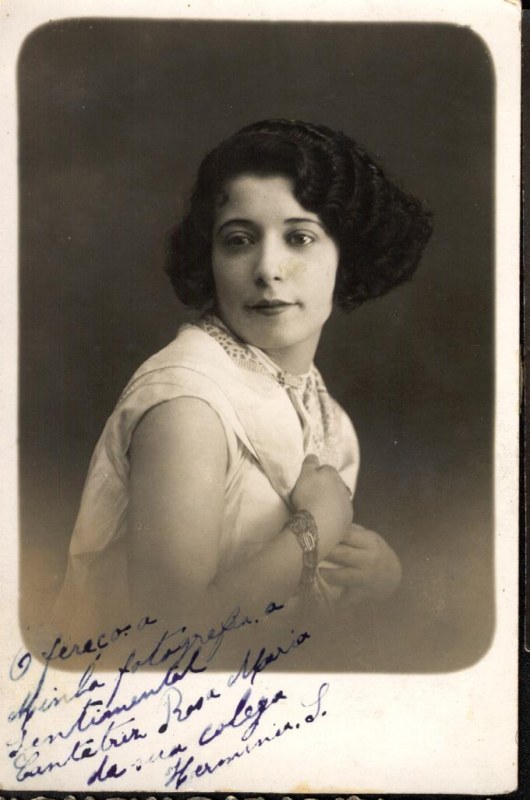
Hermínia Silva. s/d.
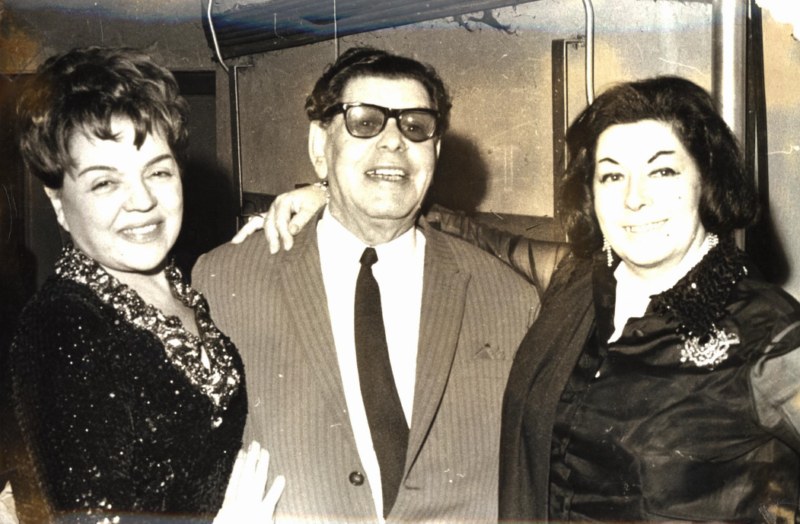
Beatriz Costa, Alfredo Marceneiro e Hermínia Silva, s/d.
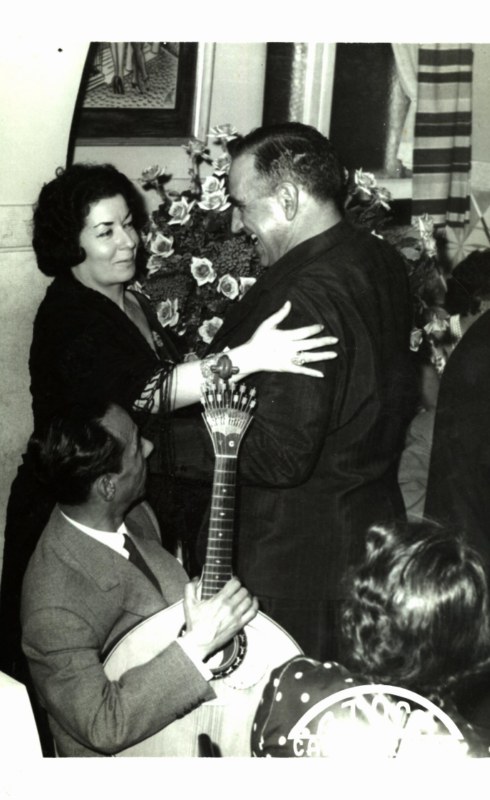
Hermínia Silva e Carlos Ramos A Toca, s/d.
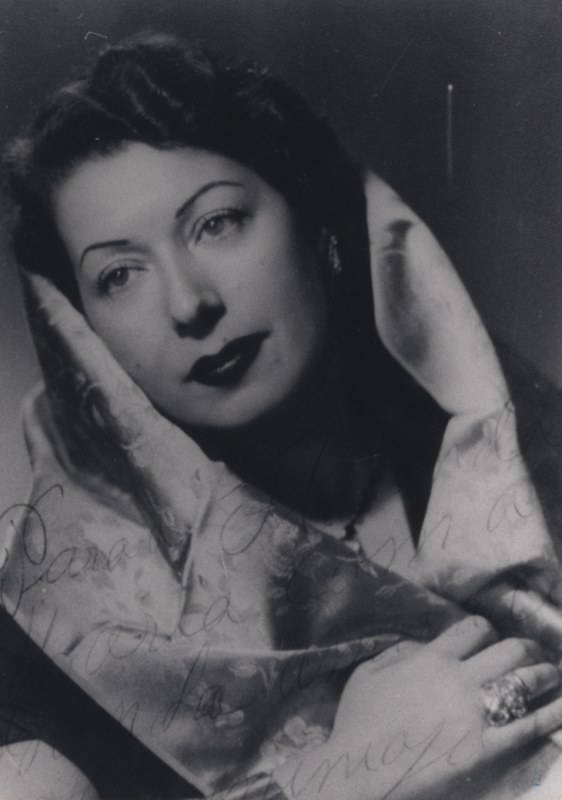
Hermínia Silva, s/d.
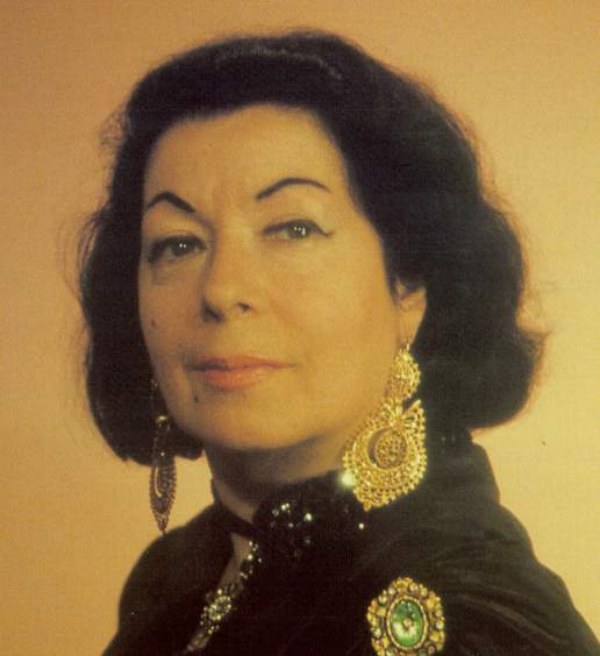
Hermínia Silva, s/d.
-
A Tendinha Hermínia Silva (José Galhardo / Raul Ferrão)

Postal de | Postcard Hermínia Silva, s/d.
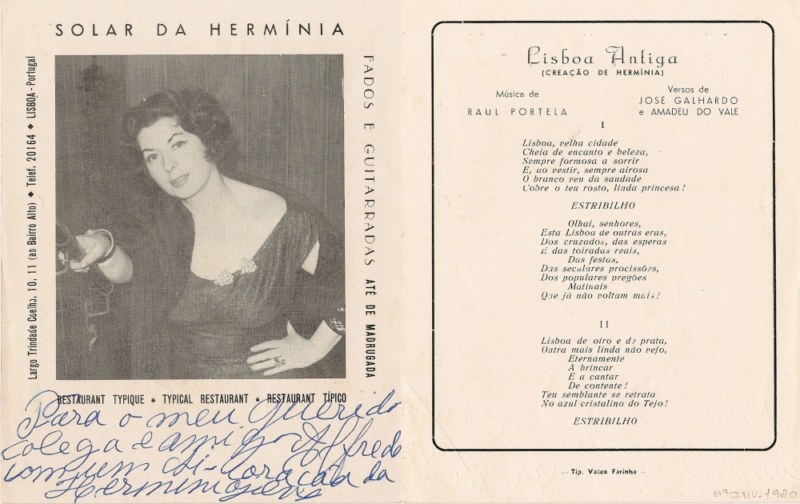
Postal do | Postcard Solar da Hermínia, s/d.
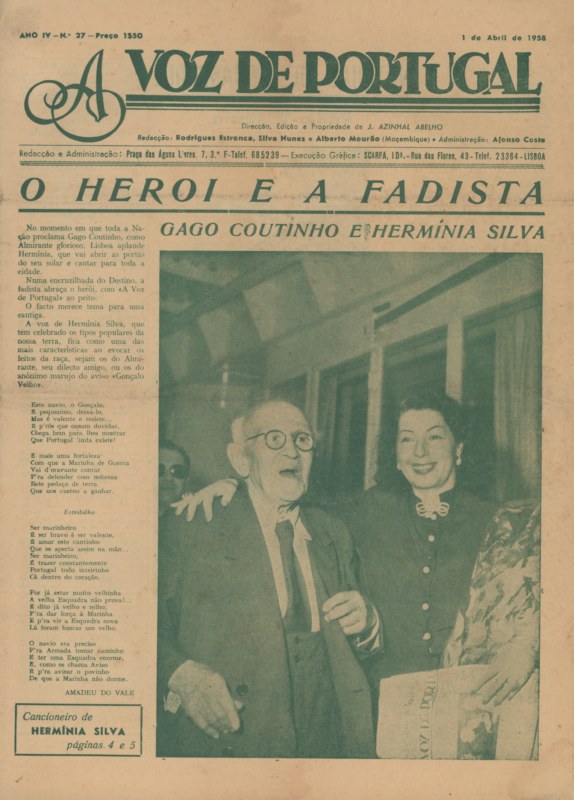
A Voz de Portugal, 1 de Abril | April 1958
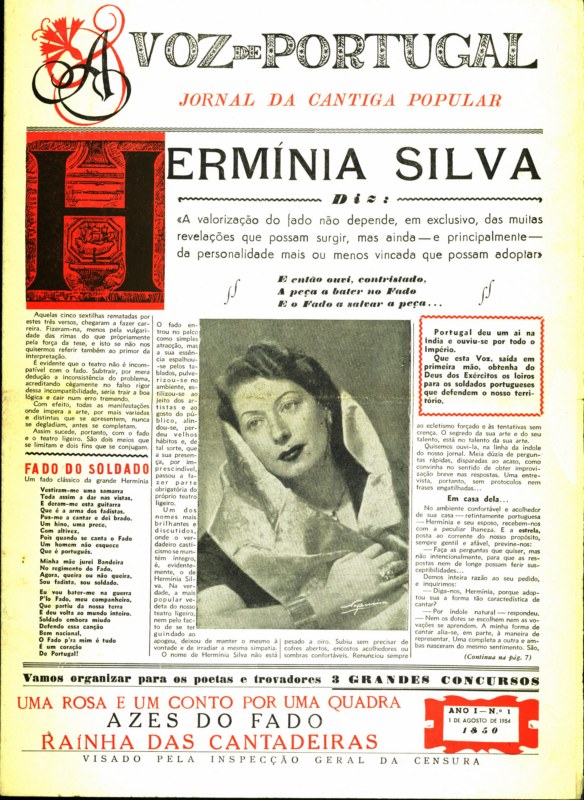
A Voz de Portugal, 1 de Agosto | August 1954
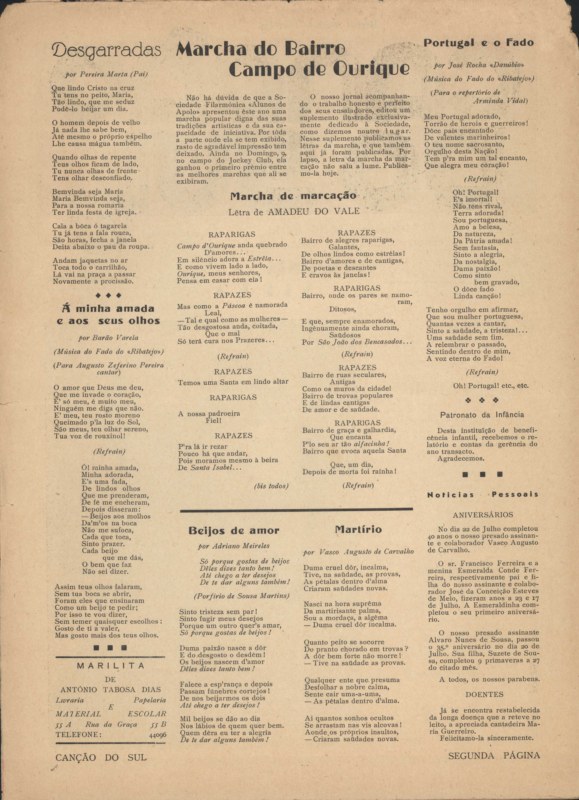
Canção do Sul, 1 de Agosto | August 1939, p. 2
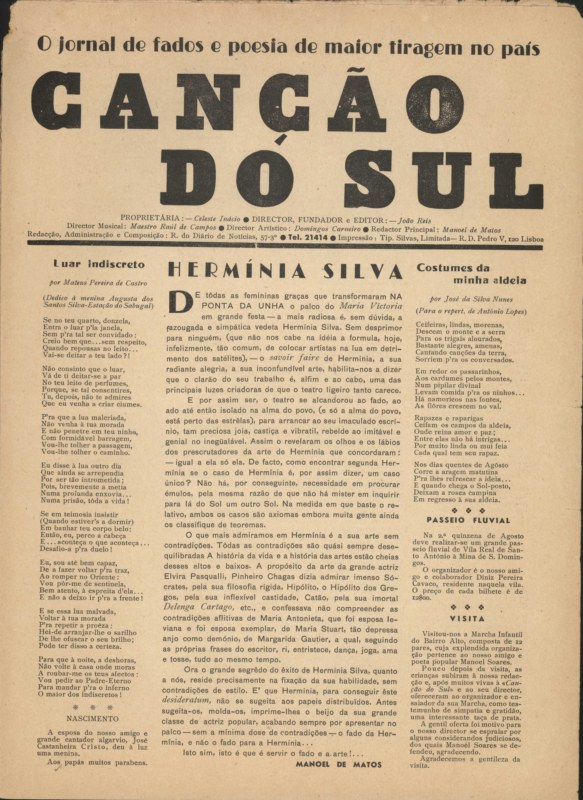
Canção do Sul, 1 de Agosto | August 1939, p. 3

Canção do Sul, 1 de Agosto | August 1939, p. 4
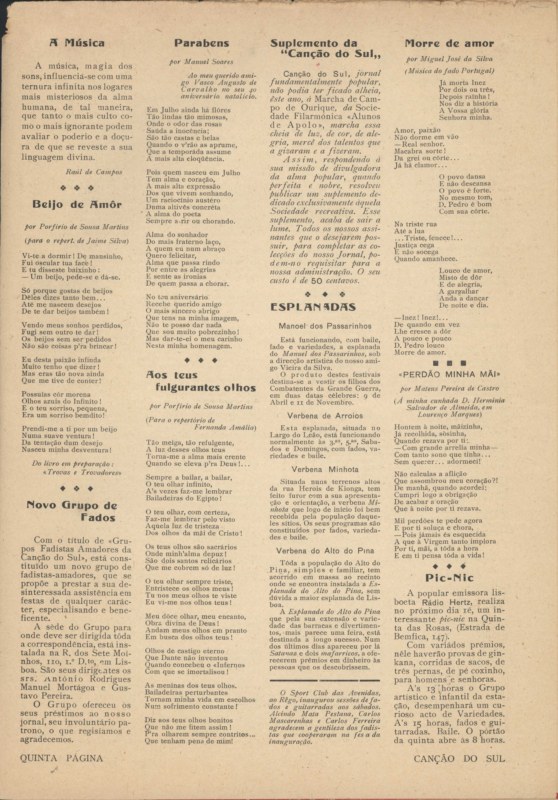
Canção do Sul, 1 de Agosto | August 1939, p. 5
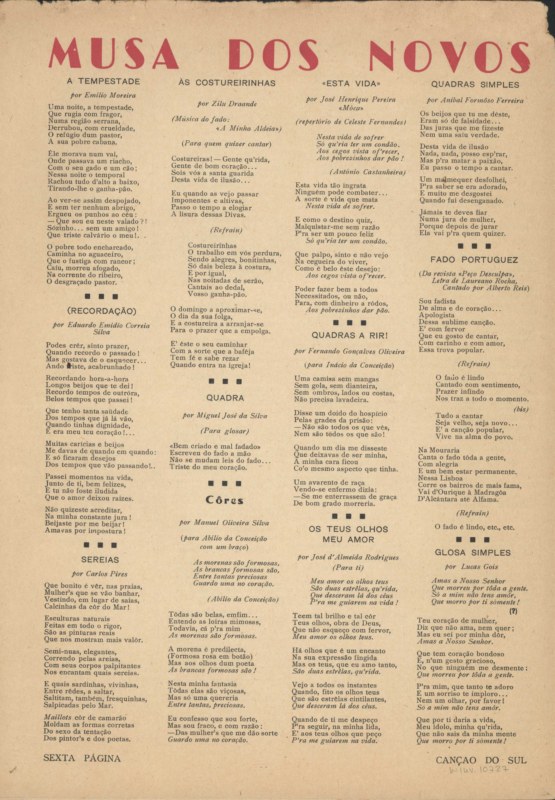
Canção do Sul, 1 de Agosto | August 1939, p. 6
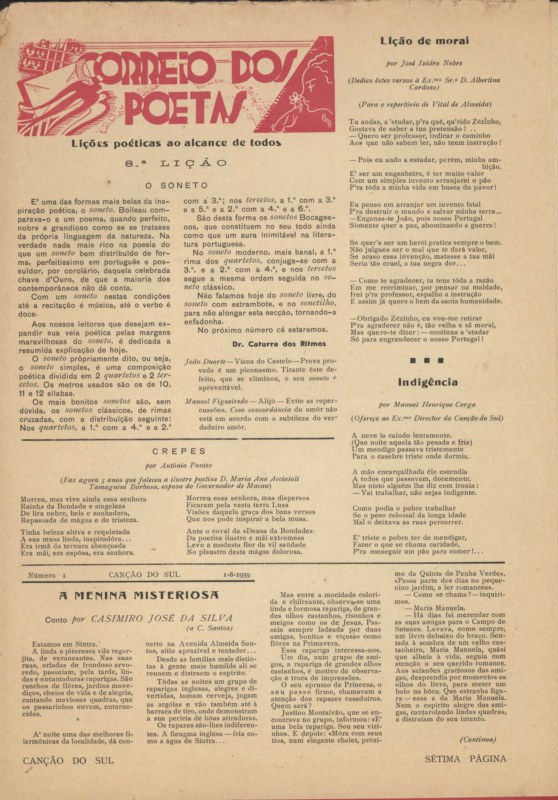
Canção do Sul, 1 de Agosto | August 1939, p. 7
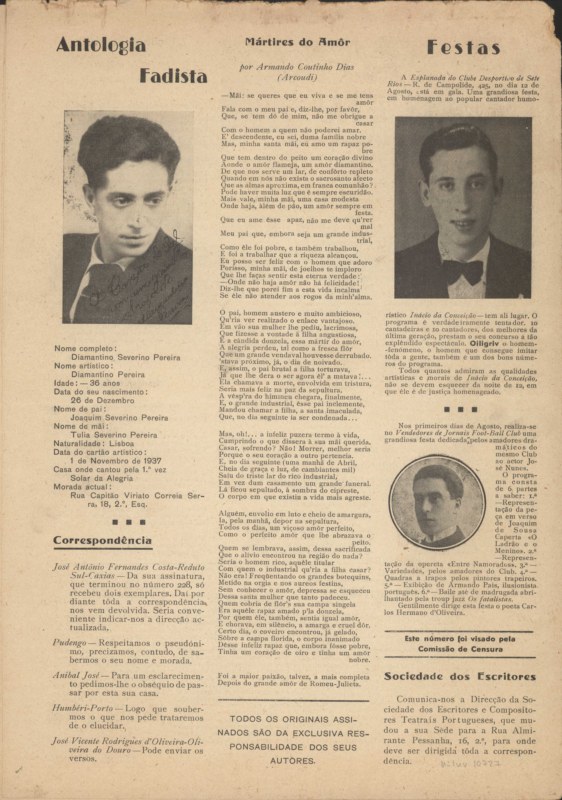
Canção do Sul, 1 de Agosto | August 1939, p. 8
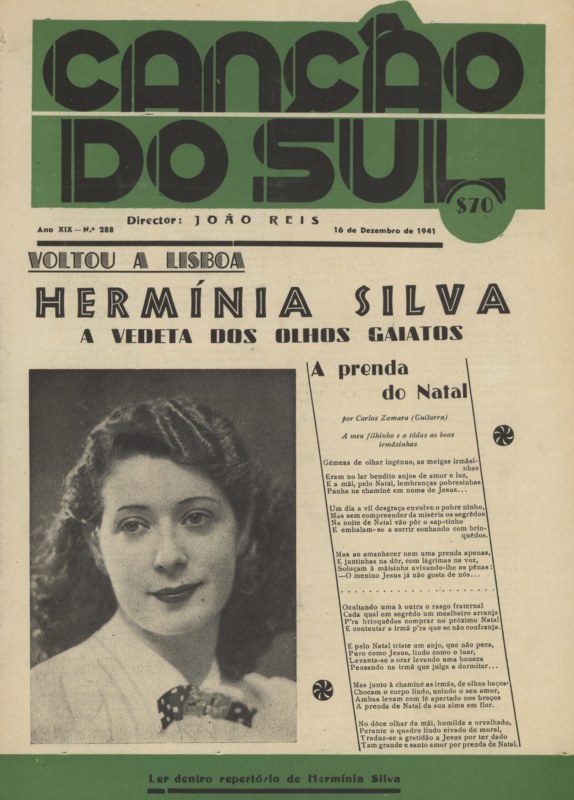
Canção do Sul, 16 de Dezembro | December 1941
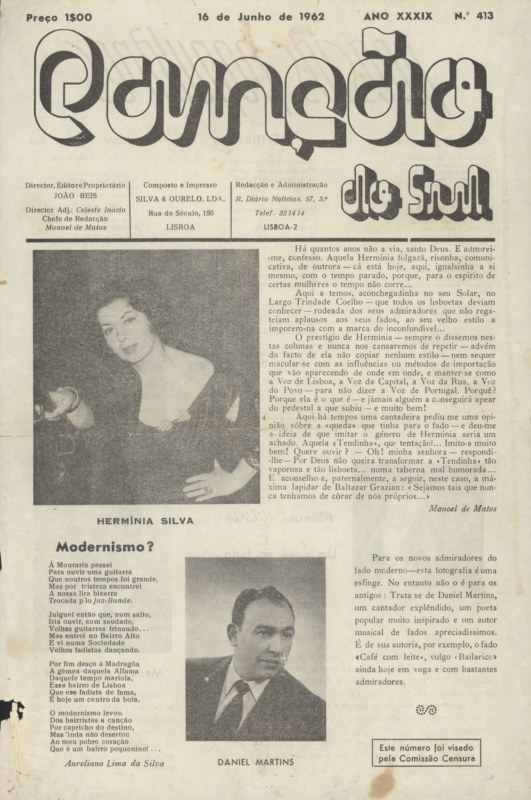
Canção do Sul, 16 de Junho | June 1962
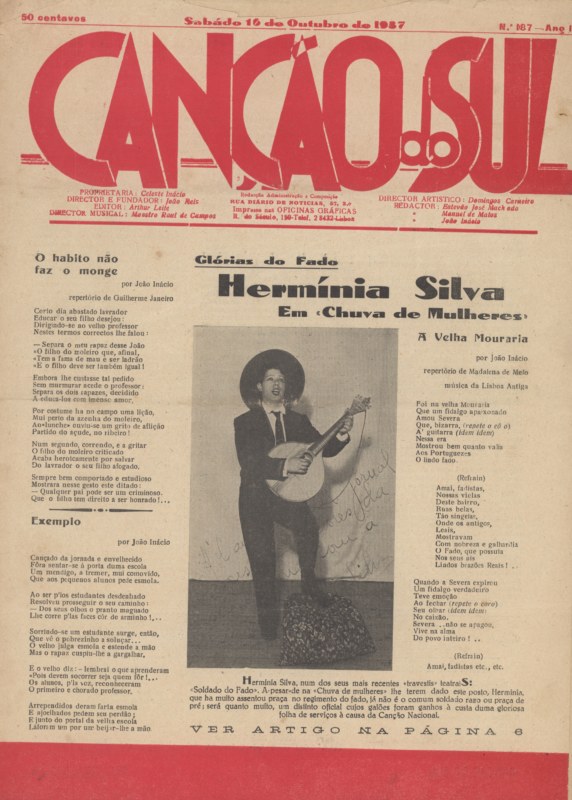
Canção do Sul, 16 de Outubro | October 1937
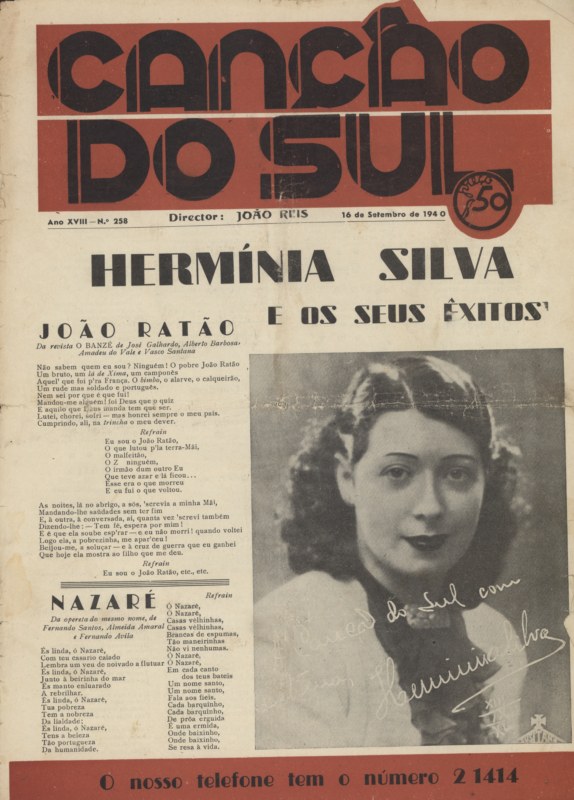
Canção do Sul, 16 de Setembro | September 1940
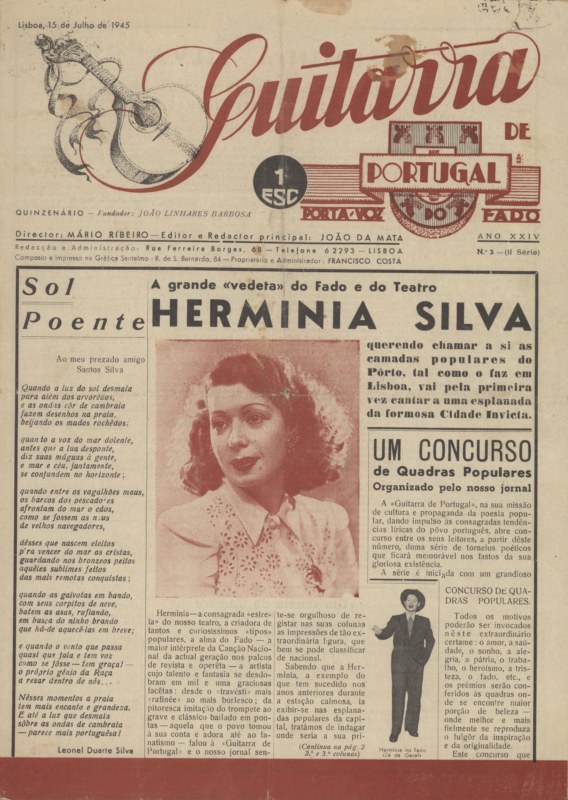
Guitarra de Portugal, 15 de Julho | July 1945
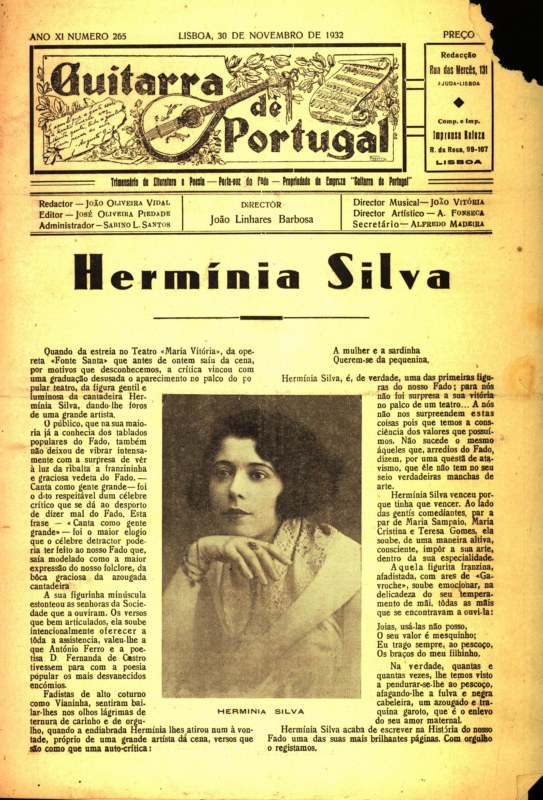
Guitarra de Portugal, 30 de Novembro | November 1932
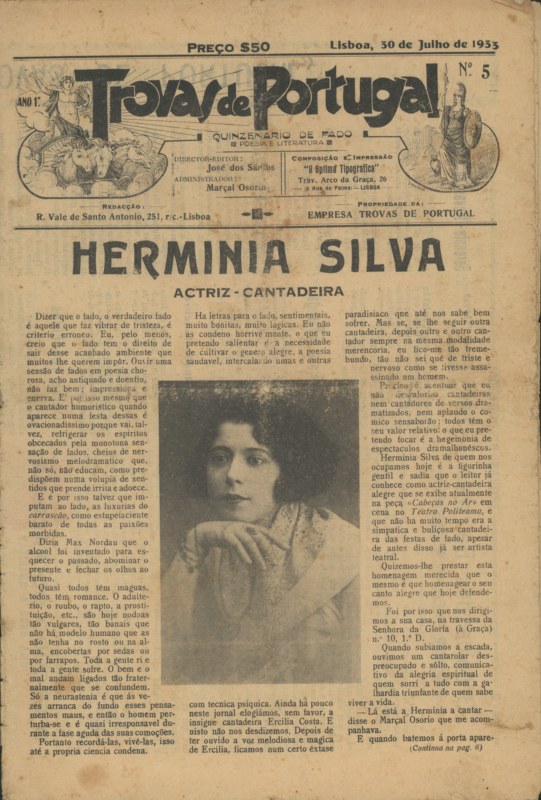
Trovas de Portugal, 30 de Julho | July 1933
